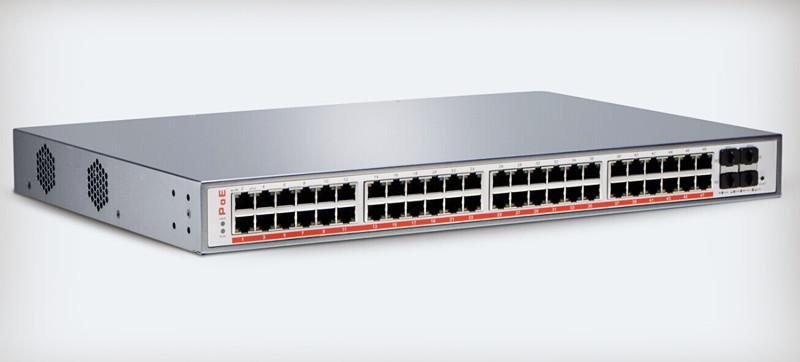Currently IP cameras are widely used for video surveillance due to the high requirements for security. Typically, the IP cameras are with PoE functions, then PoE switch is needed for the connection. But some users feel confused about the PoE switch and don’t know how to choose a suitable PoE switch. This article is going to introduce you some guides on PoE switch selection.
PoE is short for power over Ethernet. With PoE technology, data and power can be transmitted over a single Cat5e cable. A PoE switch is a device that contains multiple Ethernet ports to provide power and network communications to IP cameras. PoE switch is an economical and reliable solution for small business networks to deploy wireless access points and IP surveillance cameras.
The most important is to check whether the numbers of ports on PoE switch are enough to connect all your devices. Fiberstore offers PoE switches including 8 ports, 24 ports, and 48 ports. PoE ports are flexible to connect with Cat5e cable without additional settings. All of our PoE switches have 2 Gigabit uplink SFP ports or 4 SFP+ ports. Uplink ports allow long distance data transmission between switches. With these ports, you can easily expand your networks. (Check news about PoE switch from FS.COM: Build and Expand Your Network with FS.COM New Introduced PoE Switches) So if you need to link multiple switches, you need to select switches with enough Gigabit ports.
PoE switch applies two standards: IEEE802.3af and 802.3at. Each one can offer power for IP cameras. Due to the different standards, the output power of PoE switch is also different. IEEE802.3af can provide 15.4watts DC power on each port. As some power dissipates in the cable, only 12.95watts power at most can be supplied to powered devices. This standard is enough to power VoIP phones, wireless access points and some cameras over standard Ethernet cabling. While, IEEE802.3at is updated PoE standard known as PoE+. It can provide up to 25.5watts power available for powered device which is nearly twice as many as that 802.3af supplies. The updated standard can support more devices with high-power functionality such as door controllers, cameras with zoom capacity, or wireless access points supporting 802.11n.
PoE switch has a total power. As described before, under IEEE802.3af standard, each port on the PoE switch can get 15.4watts power. Thus, the total power of a 24-port switch must reach 370watts so that it can make sure each port get sufficient power. And make sure there is additional power beyond that required for PoE for its switching functions. As to the IEE802.3at standard, each port supports 30watts. Under this condition, the PoE switch with total power of 370watts can only provide power supply to 12 ports.
The DC power of IEEE 802.3af standard is 15.4watts. It can support 10BASE-T and 100BASE-T. Two of four twisted pairs of Cat3 cable or higher can support the power and data transmission. The PoE+ standard delivers power up to 30watts and supports 1000BASE-T. Cat5e or Cat6 cable is able to support the power transmission. Connecting PoE switch to the router or cameras with Cat5e or Cat6 cable, the maximum transmission length is up to 100 meters.
When buying Ethernet cables, find a reliable vendor who provides standard network cable meeting the strict requirement. PoE power supply must use oxygen-free copper material—standard network cable. Non-standard cable utilizes other materials such as copper clad steel, copper clad aluminum, copper coated iron, etc. These cables are not suitable for PoE power supply because of the big resistance.
PoE switch is a cost-effective solution to increase the reliability and security of networks by providing centralized backup power to all connected IP surveillance devices. Before purchasing PoE switches, try to know as more details about the switch specifications as possible and also your own needs. To get good quality PoE switches, please come to FS.COM.

